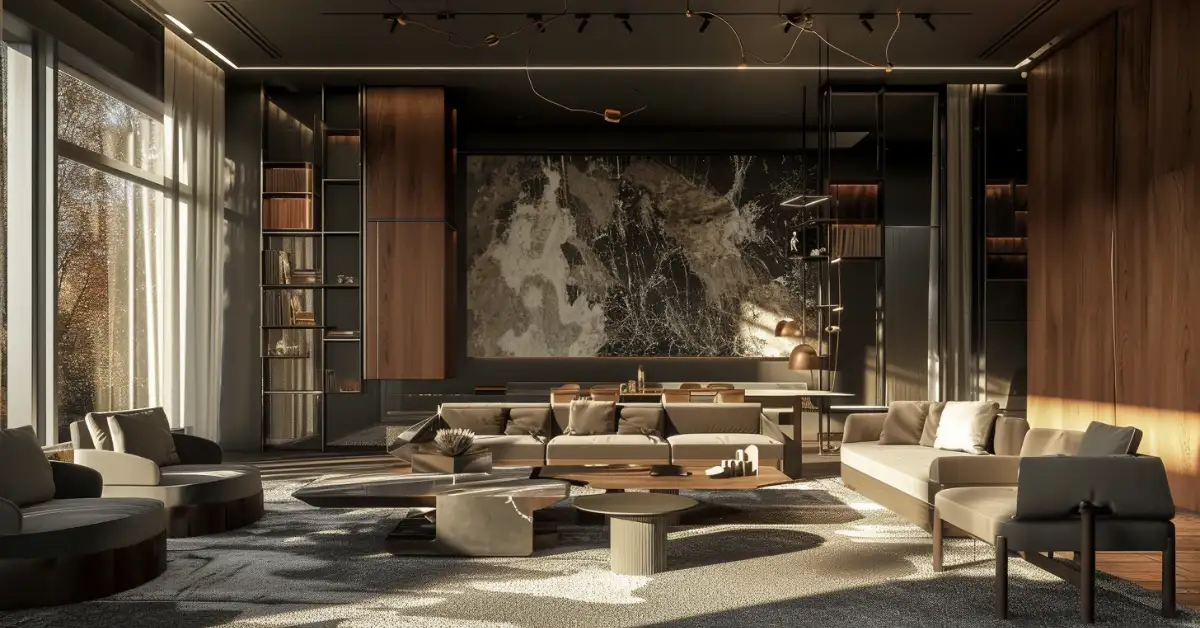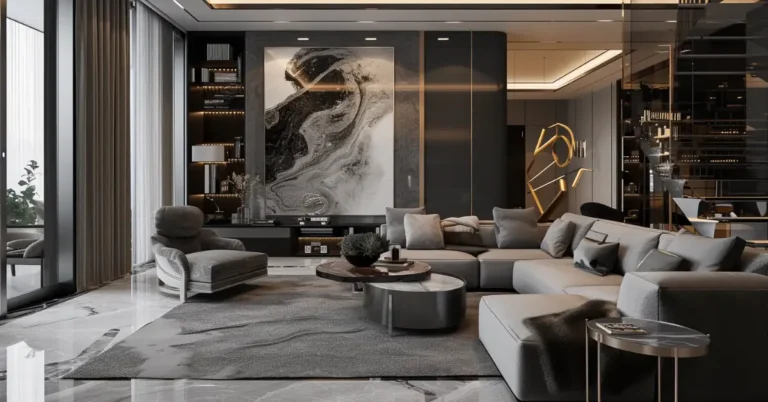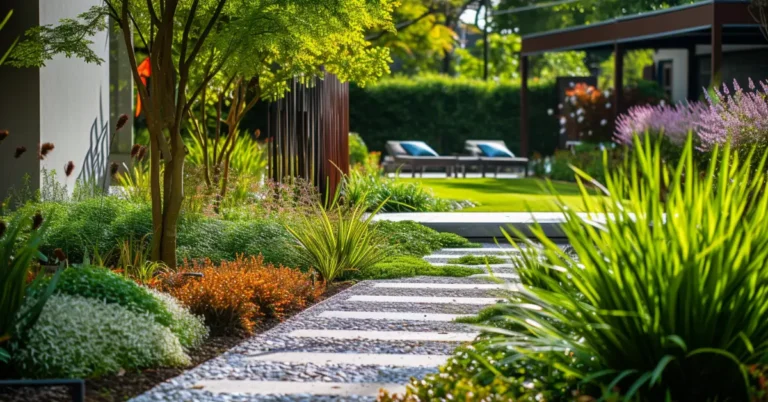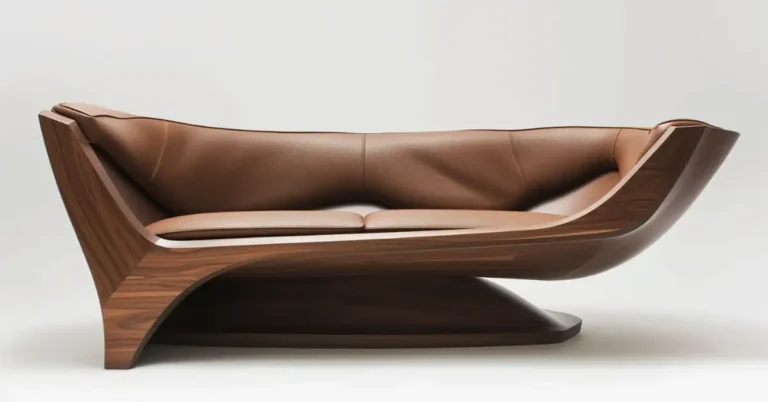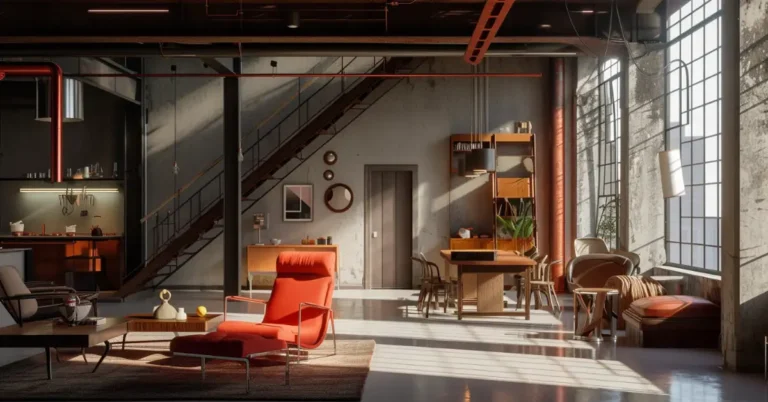If you’re as captivated by art and design as we are, chances are you’ve heard the term “contemporary design” floating around. But what is contemporary design, and how can we differentiate it from other styles?
With sleek silhouettes, neutral foundation pieces, and refined attention to editing, contemporary design can adapt to emerging trends by incorporating them into its ever-evolving approach.
What is Contemporary Design?
What is contemporary design? Unlike traditional design’s classic and ornate style, contemporary design prioritizes simplicity and functionality, reflecting the present rather than the past in its aesthetics.
“What is Contemporary” design refers to styles of the present and future. In essence, it’s a reflection of what’s currently in style and trending. This versatility means that contemporary design celebrates a mix of eclectic styles, making it a style chameleon.
One key aspect is its ability to mix and match elements from various styles. It often involves combining traditional elements with modern pieces, resulting in a harmonious and unique blend. For example, you might see a sleek, modern sofa paired with a vintage-inspired accent chair. The use of contrasting textures, materials, and colors creates a visually interesting space that still maintains a sense of cohesion and unity.
Unlike its counterpart, modern design, which is rooted in a specific movement that began in the early 20th century, contemporary design is not tied to any specific era or style. Instead, it continuously adapts to incorporate new ideas and innovations, giving it a timeless appeal. Simplicity plays a major role in contemporary design, with an emphasis on clean lines, minimal ornamentation, and functionality.

IG: covethouse_
Principles of Contemporary Design
It is an ever-evolving and dynamic style that incorporates current trends with a focus on functionality and minimalism.
Emphasis on Function
One of the main principles of contemporary design is its emphasis on function. Design elements should serve a purpose, be it practical or aesthetic. This approach prioritizes the user’s needs, resulting in spaces that are not only visually pleasing but also functional and practical. By incorporating elements that serve multiple purposes, contemporary design ensures that each piece of furniture or decor contributes to the overall functionality of the space. Clean lines and simplicity further accentuate the function-driven mindset, as they allow for efficient use of space and unhindered flow of movement.
Minimalism in Design
Another core principle in contemporary design is minimalism. This approach is all about reducing unnecessary elements and placing greater focus on the essentials that truly matter. Minimalism in design goes hand-in-hand with functionality, as it aims to create uncluttered and well-organized spaces. Through the use of clean lines, neutral color palettes, and minimalist furnishings, contemporary design gives the spotlight to the essential elements within a space.
To achieve an effective minimalist design, it is crucial to be selective with the pieces that are incorporated into the space. Every item should serve a purpose or enhance the overall aesthetic. This approach not only creates visually stunning spaces but also contributes to a comfortable and inviting atmosphere. By emphasizing function and minimalism in contemporary design, we achieve spaces that are not only visually appealing but also practical and timeless.
Elements of Contemporary Design
- Use of Lines: Lines play a crucial role in defining space and structure. Clean, straight lines dominate the scene, creating a sense of clarity and simplicity. Curved lines make an appearance too, but they’re used sparingly and strategically for a touch of elegance.
- Color in Design: The color palette leans towards a neutral color palette, featuring natural colors like grays, beiges, and whites. However, bold splashes of black or other vibrant hues can be employed as accent colors, adding some liveliness and depth to a room. Balance is key here, ensuring that the overall ambiance is not overpowering but rather welcoming and serene.
- Material Choices: Incorporates a mix of materials, reflecting a preference for high-quality, functional, and visually appealing options. Wood is a popular choice, often employed in its natural state or painted black or white to maintain a neutral palette. Metals such as chrome and nickel are also widely used, providing a sleek and polished finish to various elements within a space.
Remember, contemporary design is all about the thoughtful use of lines, color, and materials to strike a balance between form and function. So, if you’re drawn to this style, keep these guiding principles in mind as you transform your space into a contemporary haven.
Evolution of Contemporary Design
- Modern to Contemporary
- Scandinavian Influence
- Art Deco and Postmodernism
Modern to Contemporary
Contemporary design has its roots in the modernist movement. Modern design, which emerged in the early 20th century, focuses on functionality, simplicity, and clean lines. As contemporary design evolved, it borrowed elements from modernism while also incorporating its own distinctive features. Today, contemporary interiors showcase a mix of modern and vintage elements, creating an eclectic and inviting atmosphere.
Scandinavian Influence
Scandinavian design has played a significant role in shaping contemporary design. Originating in the Nordic countries, this style emphasizes minimalism, natural materials, and a connection to nature. Scandinavian or “Scandi” design brings warmth to contemporary spaces, through the use of light colors, soft textures, and organic elements. Incorporating Scandinavian elements into contemporary design adds a touch of cozy comfort to the modernist aesthetic.
Art Deco and Postmodernism
Another key influence on contemporary design is the combination of Art Deco and postmodernism. Art Deco, characterized by its ornate details and geometric patterns, adds a touch of glamour to contemporary spaces. Postmodernism, on the other hand, breaks away from the strict rules of modernism by embracing eclecticism and playful experimentation. These two styles work together to keep contemporary design fresh, dynamic, and open to interpretation.

IG: sblarts
Key Takeaways
Contemporary Design Defined: Contemporary design is a reflection of current and future design trends. It is a versatile and ever-changing style that celebrates a mix of eclectic design elements, making it adaptable to emerging trends
Eclectic and Fluid Style: Contemporary design often combines elements from various design styles, creating a harmonious blend. It can incorporate both traditional and modern
Not Tied to a Specific Era: Unlike modern design, contemporary design is not bound to any specific era or style. It continuously evolves by integrating new ideas and innovations, giving it a timeless appeal
Principles of Contemporary Design: The core principles include a strong emphasis on functionality and minimalism. Design elements should serve a practical or aesthetic purpose, and minimalism reduces unnecessary elements to create uncluttered and well-organized spaces
Elements of Contemporary Design: Clean lines, neutral color palettes, the use of natural materials, and playful patterns are key elements in contemporary design
Influence of Various Design Movements: Contemporary design has been influenced by modernism, Scandinavian design, and the fusion of Art Deco and postmodernism. These influences contribute to its eclectic and inviting character
Current Trends: Open spaces, integration of natural elements, and a fondness for retro-inspired design elements are trending in contemporary design. These trends enhance the sense of spaciousness, warmth, and playfulness in contemporary interiors
A Balance Between Form and Function: Contemporary design successfully balances aesthetics and functionality, ensuring that every design element serves a purpose while creating visually stunning and practical spaces
Trending Styles in Contemporary Design
First and foremost, contemporary design embraces uncluttered spaces. The emphasis is on open floor plans, clean lines, and a general lack of clutter. This gives a sense of airiness and calm, allowing the eye to focus on beautiful architectural features or standout pieces of furniture.
Incorporating natural elements is another important aspect of contemporary design. We often see the use of wood, stone, and other organic materials in everything from flooring to furniture, which helps to create a seamless connection between the interior and the exterior environment.
Playful patterns often make an appearance in contemporary design. Bold geometric patterns, abstract art pieces, and striking color combinations all contribute to the modern and fresh look of contemporary style.
Now let’s talk about current trends that have been making waves in the world of contemporary design. One popular trend we’ve noticed is the integration of retroelements and styles. You’ll find furniture and lighting reminiscent of mid-century modern or Art Deco, which have been updated and spun in a contemporary way.
Open spaces are key in contemporary design as well, often combining living, dining, and kitchen areas to create an expansive feel within the home. This can be achieved through the use of large windows, minimal walls, and sliding doors, which help bring the outdoors in and create a seamless flow between different parts of the house.
Finally, let’s not forget about bold art. Contemporary spaces tend to feature attention-grabbing artwork that serves as a focal point in the room. This can range from large-scale paintings to sculptures or even installations, which contribute to the distinct aesthetic of contemporary design.

Our Opinion about Contemporary Design
Contemporary design is a dynamic and versatile style that stands as a reflection of the present and a glimpse into the future. It represents a delightful blend of various design elements, continuously evolving with emerging trends. This design philosophy champions the art of mixing and matching, seamlessly weaving together traditional and modern components to create spaces that are not only aesthetically pleasing but also highly functional.
The principles of contemporary design emphasize functionality and minimalism. This approach places functionality at the forefront, ensuring that each design element serves a practical or aesthetic purpose. Minimalism, on the other hand, seeks to declutter and streamline spaces, focusing on the essentials that truly matter. The result is a harmonious balance between form and function that gives rise to inviting and uncluttered environments.
Lines, colors, and materials play pivotal roles in contemporary design. Clean lines create structure and simplicity, while a neutral color palette fosters a serene ambiance. The use of materials such as wood and stone brings nature indoors, forging a connection between the interior and exterior environments. Moreover, contemporary design often incorporates playful patterns and vibrant accents, keeping the style fresh and modern.
Contemporary design’s evolution has been influenced by a variety of design movements, notably modernism, Scandinavian design, and the fusion of Art Deco and postmodernism. These influences have given rise to contemporary interiors that exude a sense of eclecticism, elegance, and warmth, creating spaces that are both inviting and timeless.
Current trends in contemporary design highlight open spaces, the incorporation of natural elements, and a fondness for retro-inspired elements. The emphasis on open floor plans, large windows, and a seamless flow between different parts of the home enhances the sense of airiness and connection with the outdoors. Incorporating natural materials like wood and stone adds warmth, while the integration of retro design elements provides a unique and playful twist on the contemporary aesthetic.
FAQ
What is the meaning of contemporary design?
Contemporary design refers to current, up-to-date aesthetics and styles in art, architecture, and product design, emphasizing simplicity, clean lines, and a focus on functionality, often incorporating modern materials and technology.
What is an example of a contemporary design?
A contemporary design example is a minimalist, open-concept kitchen with sleek cabinetry, neutral colors, and integrated smart appliances, reflecting current trends in both aesthetics and technology.
What is modern vs contemporary design?
Modern design refers to a specific style from the mid-20th century, characterized by clean lines and minimalism. Contemporary design is ever-evolving and represents current aesthetics, embracing a wider range of styles and influences, often including modern elements but not limited to them.
What is the difference between traditional and contemporary design?
Traditional design is classic and ornate, while contemporary design is clean and current, focusing on simplicity and function. The difference is in their aesthetics, with a tradition rooted in the past and contemporary reflecting the present.
If you liked this blog post about the topic: “What is contemporary design”, don’t forget to leave us a comment down below to tell us about your experience with it.
If you want to keep reading more from us, have a look at these articles.

